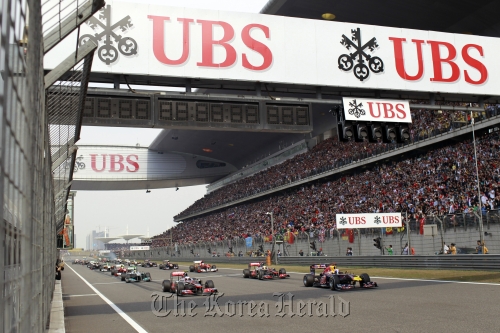How could anyone have ever thought the 2011 Formula One season was going to be a walkover for any driver?
Yes, Red Bull’s championship leader Sebastian Vettel has the fastest package. But with the introduction of the Pirelli tires, Drag Reduction System and KERS, the 2011 F1 Grand race is not all about speed ― it is about strategic wisdom, big brains, big guts. And these are far more complicated than the old “just build a fast car and run away” days.
The last week’s Shanghai Grand Prix proved that a fast car is not enough when someone turns up with a better tire choice.
To see and enjoy all these aspects of the race, you need to understand the basics of the Formula One.
At each Grand Prix, all race drivers may participate in three practice sessions on Friday and Saturday morning, before entering the one-hour qualifying session on Saturday afternoon. The qualifying session decides the starting order for the main race on Sunday.
 |
F1 racing cars line up on the grid at the start of the Chinese Grand Prix on April 17. (LAT Photographic) |
Pole position
The qualifying session is divided into three parts. First, all 24 cars may run laps at any time during the first 20 minutes of the hour. At the end of the first 20 minutes, the seven slowest cars drop out and fill the final seven grid places. However, any driver whose best Q1 lap time exceeds 107 percent of the fastest time set during that session will not be allowed to take part in the race.
After a break, the times will be reset and the 17 remaining cars then will run in a 15-minute session. Again at the end the Q2, the seven slowest cars drop out and fill places 11 to 17 on the grid. Finally, a final 10-minute session will feature a shootout between the remaining 10 cars to decide pole position and the starting order for the top 10 grid places for the race.
Pit stop
With the fastest driver taking the pole position, qualifying session is a standard test of pure speed. But the real race on Sunday takes approximately one hour and a half, and the drivers have to complete around 320km.
The cars cannot run the total distance with just one set of tires, so the drivers have to make pit stops during the race to change them. Drivers and teams are free to change tires whenever during the race. And this pit stop is an essential point of their strategy, because of the variables that keep changing during the race. To have everything under control is impossible during the race, but that is why it is exciting for the drivers, teams and spectators.
By Recardo Bruins (
RB@swa.co.kr)
Korea-born Dutch racing driver Recardo Bruins, whose Korean name is Choi Myung-gil, is an honorary ambassador of the 2011 Korean Grand Prix. ―Ed.








